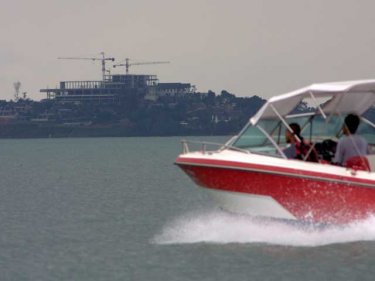A SUBTLE but important change in attitude has taken place on the islands east of Phuket and west of Phang Nga.
These two idyllic tropical spots, seemingly designed and perfected by Nature for glamorous resorts and villas with yachts bobbing nearby, are now far less likely to become home to large-scale developments.
The reason why the islands are no longer the next Andaman property frontier are complicated, yet at the same time, extremely simple.
It all has to do with perceptions.
And the perception among many people who live on the islands is that large-scale luxury developments do not necessarily benefit traditional communities.
STARTING today, the first historic two-day gathering between the communities of the islands of Phuket and Phang Nga is being held to compare notes and discuss the future.
The meeting includes about 300 traditional village leaders, and legal advisers.
It may yet become just a passing phase in the continuing development of Phuket.
But it could also be a turning-point, a historic milestone denoting the end of one era, and a new beginning.
Ironically, two high-end brands, Yamu and Jumeirah, have played their part in generating today's gathering. So, to a lesser extent, has a third, Evason Six Senses Hideaway.
Many of the islander participants travelling to Koh Yao Yai today will pass the construction sites that currently mark Yamu and Jumierah.
They are unlikely to look at the two developments and see what the architects and developers of the projects see.
And that is where perception becomes the important point.
The vision of the architects and developers is based on a time in the future when Yamu and Jumeirah are state-of-the-art destinations, snuggled neatly into headland and island, green and beautiful.
The vision of the islanders is based on what they see now, all earth-movers and brown dirt, where once there was a headland and an island, green and beautiful.
The same issue of perception will arise soon on Koh Lon, off the coast from Chalong, where the Taj Exotica is scheduled to be built at a cost that amounts to about $US900,000 a key.
Some people may be impressed with the thought of sumptuous resort bedrooms that lift big money luxury to the next level.
Most of the islanders are not. They will never see the inside of the $900,000 pool villas.
And that's why the difference in perception is so important.
Many people, especially those raised in societies based on individual accumulation and materialism, look at a plot of land and imagine ways it could be ''improved.''
They see the right kind of development as a profitable enhancement.
On the other hand, most traditional villagers from the islands seek continuity. They want to maintain their way of life, unchanged, and they retain a deep sense of community well-being.
While there are some who own land and who will no doubt be tempted by the big money on offer in future, their reaction is no longer a foregone conclusion.
This is largely because they do not like what they see at the Yamu and Jumeirah construction sites.
Now, it could be that the finished products will have much more appeal. There will be jobs. There may be support for community projects.
But for now, the divide between the perception of the brands and their architects and their close neighbors has never been greater.
Villagers and visitors have travelled on the ferries past Jumeirah and Yamu, day in and day out.
For now, the ugliness of the construction sites holds sway.
PERCEPTIONS can change. We know of one group of sea gypsies who abandoned their traditional island life off Phang Nga after the tsunami of 2004.
Anthropologists thought that the more developed mainland would treat them cruelly.
Yet quite the opposite has happened. The sea gypsies, closer to good health care and better educational opportunities, are thriving.
And now, on the mainland, they have a direct say in their own future.
Perceptions can change. We know of another beautiful island off Phang Nga, where the local people sought a relationship with an ecotourism brand.
Then they discovered that, while they did most of the work and earned 1000 baht per visitor, the ecotourism brand pocketed five times that much.
That's one reason why they, along with other island communities in the region, are keen to develop a reputation for quality tourism based on home-stays and traditional life.
Continuity, the vital link with the past, is maintained, and the real islands, rather than an imported resort version, can be enjoyed by everybody, not just a rich few.
It will be interesting to watch, over the next five years, as the Yamu and Jumeirah sites change and grow to more closely resemble the vision of the architects.
Will the perceptions of their neighbors change, too?
The future of other large-scale resort developments may have already been determined by the traditional villagers, meeting over the next couple of days.
These two idyllic tropical spots, seemingly designed and perfected by Nature for glamorous resorts and villas with yachts bobbing nearby, are now far less likely to become home to large-scale developments.
The reason why the islands are no longer the next Andaman property frontier are complicated, yet at the same time, extremely simple.
It all has to do with perceptions.
And the perception among many people who live on the islands is that large-scale luxury developments do not necessarily benefit traditional communities.
STARTING today, the first historic two-day gathering between the communities of the islands of Phuket and Phang Nga is being held to compare notes and discuss the future.
The meeting includes about 300 traditional village leaders, and legal advisers.
It may yet become just a passing phase in the continuing development of Phuket.
But it could also be a turning-point, a historic milestone denoting the end of one era, and a new beginning.
Ironically, two high-end brands, Yamu and Jumeirah, have played their part in generating today's gathering. So, to a lesser extent, has a third, Evason Six Senses Hideaway.
Many of the islander participants travelling to Koh Yao Yai today will pass the construction sites that currently mark Yamu and Jumierah.
They are unlikely to look at the two developments and see what the architects and developers of the projects see.
And that is where perception becomes the important point.
The vision of the architects and developers is based on a time in the future when Yamu and Jumeirah are state-of-the-art destinations, snuggled neatly into headland and island, green and beautiful.
The vision of the islanders is based on what they see now, all earth-movers and brown dirt, where once there was a headland and an island, green and beautiful.
The same issue of perception will arise soon on Koh Lon, off the coast from Chalong, where the Taj Exotica is scheduled to be built at a cost that amounts to about $US900,000 a key.
Some people may be impressed with the thought of sumptuous resort bedrooms that lift big money luxury to the next level.
Most of the islanders are not. They will never see the inside of the $900,000 pool villas.
And that's why the difference in perception is so important.
Many people, especially those raised in societies based on individual accumulation and materialism, look at a plot of land and imagine ways it could be ''improved.''
They see the right kind of development as a profitable enhancement.
On the other hand, most traditional villagers from the islands seek continuity. They want to maintain their way of life, unchanged, and they retain a deep sense of community well-being.
While there are some who own land and who will no doubt be tempted by the big money on offer in future, their reaction is no longer a foregone conclusion.
This is largely because they do not like what they see at the Yamu and Jumeirah construction sites.
Now, it could be that the finished products will have much more appeal. There will be jobs. There may be support for community projects.
But for now, the divide between the perception of the brands and their architects and their close neighbors has never been greater.
Villagers and visitors have travelled on the ferries past Jumeirah and Yamu, day in and day out.
For now, the ugliness of the construction sites holds sway.
PERCEPTIONS can change. We know of one group of sea gypsies who abandoned their traditional island life off Phang Nga after the tsunami of 2004.
Anthropologists thought that the more developed mainland would treat them cruelly.
Yet quite the opposite has happened. The sea gypsies, closer to good health care and better educational opportunities, are thriving.
And now, on the mainland, they have a direct say in their own future.
Perceptions can change. We know of another beautiful island off Phang Nga, where the local people sought a relationship with an ecotourism brand.
Then they discovered that, while they did most of the work and earned 1000 baht per visitor, the ecotourism brand pocketed five times that much.
That's one reason why they, along with other island communities in the region, are keen to develop a reputation for quality tourism based on home-stays and traditional life.
Continuity, the vital link with the past, is maintained, and the real islands, rather than an imported resort version, can be enjoyed by everybody, not just a rich few.
It will be interesting to watch, over the next five years, as the Yamu and Jumeirah sites change and grow to more closely resemble the vision of the architects.
Will the perceptions of their neighbors change, too?
The future of other large-scale resort developments may have already been determined by the traditional villagers, meeting over the next couple of days.




